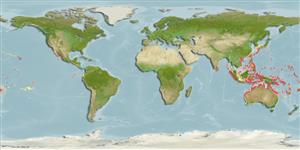>
Blenniiformes (Blennies) >
Tripterygiidae (Triplefin blennies) > Tripterygiinae
Etymology: Enneapterygius: Greek, ennea = nine times + Greek, pterygion = little fin (Ref. 45335).
Environment: milieu / climate zone / depth range / distribution range
Ekologi
marina revassocierade; djupintervall 0 - 22 m (Ref. 27223). Tropical
Western Central Pacific.
Size / Vikt / Age
Maturity: Lm ? range ? - ? cm
Max length : 3.2 cm TL hane/ej könsbestämd; (Ref. 90102)
Short description
Bestämningsnycklar | Morfologi | Morfometri
Taggstrålar i ryggfenan (totalt) : 14 - 15; Mjukstrålar i ryggfenan (totalt) : 8 - 10; Taggstrålar i analfenan: 1; Mjukstrålar i analfenan: 17 - 18. Male dark grey with large yellow patch dorsally on head, and lower head and pectoral-fin base black. Female tan with 5 double brown bars on side. Both sexes with black bar at caudal-fin base preceded by white bar/saddle. Dorsal rays III + XI-XII + 8-10; anal rays I,17-18; pectoral rays 14-17; pelvic rays I,2; lateral line interrupted 15-17 + 17-22; head, chest, and pectoral-fin base scaleless; short orbital tentacle present; mandibular pores 3 + 1 + 3. Maximum size to 3.2 cm TL (Ref. 90102).
Adults occur on rocky substrates in association with coral reefs or coral reef lagoons, from shallow areas to the outer reef slope, also in intertidal rock pools (Ref. 13227, 27223). Eggs are hemispherical and covered with numerous sticky threads that anchor them in the algae on the nesting sites (Ref. 240). Larvae are planktonic which occur primarily in shallow, nearshore waters (Ref. 94114).
Life cycle and mating behavior
Maturities | Reproduktion | Spawnings | Egg(s) | Fecundities | Larver
Springer, V.G. and T.M. Orrell, 1996. Catalog of type specimens of recent fishes in the National Museum of Natural History, Smithsonian Institution, 5: Chaenopsidae, Clinidae, Dactyloscopidae, Labrisomidae, and Tripterygiidae. Smithson. Contrib. Zool. 576:38. (Ref. 13293)
IUCN Red List Status (Ref. 130435)
Threat to humans
Harmless
Human uses
Verktyg
Special reports
Download XML
Internet-källor
Estimates based on models
Preferred temperature (Ref.
123201): 24.7 - 29.3, mean 28.5 °C (based on 2149 cells).
Phylogenetic diversity index (Ref.
82804): PD
50 = 0.5000 [Uniqueness, from 0.5 = low to 2.0 = high].
Bayesian length-weight: a=0.00562 (0.00258 - 0.01228), b=3.08 (2.89 - 3.27), in cm total length, based on LWR estimates for this (Sub)family-body shape (Ref.
93245).
Trofisk nivå (Ref.
69278): 3.1 ±0.3 se; based on size and trophs of closest relatives
Resiliens (Ref.
120179): Hög, lägsta populationsfördubblingstid mindre än 15 månader (Preliminary K or Fecundity.).
Fishing Vulnerability (Ref.
59153): Low vulnerability (10 of 100).
Nutrients (Ref.
124155): Calcium = 636 [181, 3,816] mg/100g; Iron = 3.46 [0.93, 9.61] mg/100g; Protein = 18.1 [15.9, 20.2] %; Omega3 = 0.098 [0.016, 0.665] g/100g; Selenium = 104 [12, 665] μg/100g; VitaminA = 23.6 [1.9, 282.4] μg/100g; Zinc = 7.75 [2.73, 17.14] mg/100g (wet weight);
